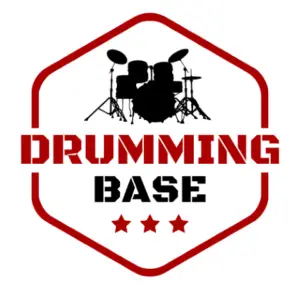In the vast majority of live band performances, the drummers will be at the back in the centre, but why is this?
Drummers typically sit at the back on stage because the sound would be too overwhelming if they were placed further forward. Having the drum set at the back also helps to save space and ensure the other members of the band are not blocked and have space to move around on stage.
To Balance the Sound
One of the main reason why the drum kit needs to be at the back of the stage is to balance the overall sound of the band. Drums are incredibly loud even without any amplification, so placing them at the back prevents them from becoming overwhelming.
If the drums were to be at the front of the stage, they would be much louder and it would make it harder to balance the sound of the entire band and prevent the drums from taking over.
In larger venues, there will be a lot of microphones surrounding the drum kit as it won’t be loud enough on its own. There microphones are directional, which means that they don’t take in much sound from behind them, and mostly take in sound from directly in front of them. However, the microphones will still take in some sound from the sides.
If the drums were placed towards the front of the stage, the microphones would pick up more noise from the surroundings (such as the singer’s mic) compared to if they were placed at the back where the wall is blocking some of the sound out. Hence, the sound quality is better if the drums are at the back.

To Save Space
Drums take up the most space on stage and placing them at the back prevents this from becoming too much of an issue.
An average 5-piece drum kit takes up 75″ x 55″ of space, which is significantly more than any other instrument requires. The guitarists, bass player and singer only really require a small amount of space around them to stand comfortably without getting in each others way.
Tucking the drums away at the back avoids them taking too much space, as you don’t need to consider the space to the sides or behind them either.
Some space will be needed in front of the kit to ensure the other band members have space to move, however if the drum kit was placed at the front instead, you’d need a lot more space around it.
Hence, this positioning allows the other members of the band to move more freely around the stage which drummers of course are unable to do anyway.
So Other Members of the Band Are Not Blocked
This reason is linked to the previous one. Drum kits are very large and if they were placed towards the front of the stage, the other band members would be difficult to see.
Placing the drummer at the back ensures that they can still be seen, but without blocking all the other band members. The only time where this wouldn’t be an issue is if the stage was very wide and the vocalist, guitar and bass players could stand to the side of the drummer, but this is very rare.
Drummers are often regarded as accompanists, and the lead vocalist and guitar player is often considered the “star” of the show. This is unfair as drummers are very talented, but it just is how most bands are organised. Hence, it makes most sense for them to sit at the back so they don’t steal the limelight too much.
So the Drummer is Able to See the Rest of the Band
Drummers have a crucial role in the band to provide the beat that all the other band members stick to. It’s often described that drummers are the “spine” of the band, and the other band members branch off. This fits well with their spatial positioning on the stage.
It’s important for the drummer to be able to see the other members of the band to get cues from them. A lot of communication goes on during a live performance and placing the drummer at the back allows them to see what’s going on more.
A Few Exceptions
It’s important to note that there are some exceptions where the drummers do not sit at the back of the stage and instead are further up front, for example The Dave Clark Five and Joy Formidable.
The two occasions where its more likely for a drummer to be placed to the side are either when they are also a lead singer, or if it is a three-piece band.
Here are some more articles you might find interesting:

